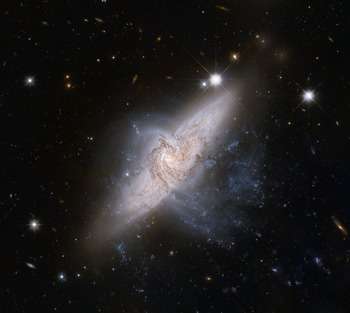NGC 3314
| NGC 3314 | |
|---|---|
|
NGC 3314a (foreground) and NGC 3314b (background) taken by the Hubble Space Telescope | |
| Observation data (J2000 epoch) | |
| Constellation | Hydra |
| Right ascension | 10h 37m 12.5s |
| Declination | -27° 41' 05" |
| Redshift |
+0.0095 (a) +0.01548 (b) |
| Distance |
117 Mly (a) 140 million ly (b) |
| Apparent magnitude (V) | +12.5 |
| Characteristics | |
| Type | SBbc/SAab |
| Apparent size (V) | 2′.6 × 1′.7 |
| Notable features | galaxy overlapping another |
| Other designations | |
| |
NGC 3314 is a pair of overlapping spiral galaxies between 117 and 140 million light-years away in the constellation Hydra. This unique alignment gives astronomers the opportunity to measure the properties of interstellar dust in the face-on foreground galaxy (NGC3314a), which appear dark against the background galaxy (NGC 3314b). Unlike interacting galaxies, the two components of NGC3314 are physically unrelated. It was discovered in April 1999.
In a March 2000 observation of the galaxies, a prominent green star-like object was seen in one of the arms. Astronomers theorized that it could have been a supernova, but the unique filtering properties of the foreground galaxy made it difficult to decide definitively.[1]
References
- ↑ Keel, Bill; Frattare, Lisa. "NGC 3314 Variable Object". heritage.stsci.edu. Retrieved 2015-11-05.
External links
- NASA Astronomy Picture of the Day: When Galaxies Overlap (7 May 2005)
- SPACE.com: Hubble Spies Galactic Dust Silhouette
- Simbad: NGC 3314 -- Interacting Galaxies
- NGC 3314 on WikiSky: DSS2, SDSS, GALEX, IRAS, Hydrogen α, X-Ray, Astrophoto, Sky Map, Articles and images
This article is issued from Wikipedia - version of the 9/30/2016. The text is available under the Creative Commons Attribution/Share Alike but additional terms may apply for the media files.
